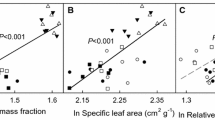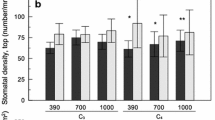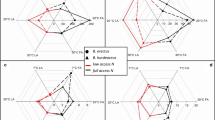Abstract
Increasing atmospheric CO2 concentration is regarded as an important factor facilitating plants invasions by stimulating invasive species growth. However, the physiological mechanisms by which invasive plants increase at the expense of existing native plants are poorly understood. Plant growth is always related to energy-use process including energy assimilation and expenditure, and thus examination of energetic properties could provide mechanistic insight into growth responses to increased CO2. The aims of this study were to examine the effect of rising CO2 on the growth and energetic properties of alien invasive species (Wedelia trilobata (L.) Hitchc.) and its native congener (Wedelia chinensis (Osbeck.) Merr.) in South China, and to determine if the specific energetic properties of invasive species at elevated CO2 favoring its growth. Elevated CO2 stimulated a greater increase in biomass production for invasive W. trilobata (58.9%) than for its indigenous congener (48.1%). Meanwhile, elevated CO2 altered the energetic properties differently upon species. For invasive W. trilobata, elevated CO2 significantly increased total energetic gain via photosynthetic activity (A total), but decreased energetic cost of biomass construction (CC), and thus enhanced photosynthetic energy-use efficiency (PEUE) by 85.3%. In contrast, the indigenous W. chinensis showed a slight increase in PEUE by 43.8%. Additionally, W. trilobata individuals grown in elevated CO2 increased energy allocation towards stems. Statistic analysis revealed significant associations between growth characteristics (relative growth rate and biomass) and energetic properties (CC and PEUE), suggesting the greater growth stimulation in invasive species could be partly explained by its specific energetic properties in elevated CO2 concentration. The invasive species showed a greater increase in energy-use efficiency under elevated CO2, which consequently facilitated its growth. It might be a physiological mechanism promoting success of invasion with ongoing increase in atmospheric CO2 concentration.



Similar content being viewed by others
References
Amthor JS, Mitchell RJ, Runion G, Rogers HH, Prior SA, Wood CW (1994) Energy content, construction cost and phytomass accumulation of Glycine max (L.) Merr. and Sorghum bicolor (L.) Moench grown in elevated CO2 in the field. New Phytol 128:443–450
Baruch Z, Goldstein G (1999) Leaf construction cost, nutrient concentration, and net CO2 assimilation of native and invasive species in Hawaii. Oecologia 121:183–192
Baruch Z, Gómez JA (1996) Dynamics of energy and nutrient concentration and construction cost in a native and two alien C4 grasses from two neotropical savannas. Plant Soil 181:175–184
Booker FL, Shafer SR, Wei C, Horton SJ (2000) Carbon dioxide enrichment and nitrogen fertilization effects on cotton (Gossypium hirsutum L.) plant residue chemistry and decomposition. Plant Soil 220:89–98
Bowes G (1993) Facing the inevitable: plants and increasing atmospheric CO2. Annu Rev Plant Physiol Plant Mol Biol 44:309–332
Cotrufo MF, Ineson P, Scott A (1998) Elevated CO2 reduces the nitrogen concentration of plant tissues. Global Change Biol 4:43–54
Curtis P, Wang X (1998) A meta-analysis of elevated CO2 effects on woody plant mass, form, and physiology. Oecologia 113:299–313
Deng X, Ye WH, Feng HL, Yang QH, Cao HL, Xu KY, Zhang Y (2004) Gas exchange characteristics of the invasive species Mikania micrantha and its indigenous congener M. cordata (Asteraceae) in South China. Bot Bull Acad Sinica 45:213–220
Dukes JS, Mooney HA (1999) Does global change increase the success of biological invaders? Trends Ecol Evol 14:35–139
Durand LZ, Goldstein G (2001) Photosynthesis, photoinhibition, and nitrogen use efficiency in native and invasive tree ferns in Hawaii. Oecologia 126:345–354
Forseth IN, Innis AF (2004) Kudzu (Pueraria montana): history, physiology, and ecology combine to make a major ecosystem threat. Criti Rev Plant Sci 23:401–413
George K, Norby RJ, Hamilton JG, DeLucia EH (2003) Fine-root respiration in a loblolly pine and sweetgum forest growing in elevated CO2. New Phytol 160:511–522
Griffin KL (1994) Calorimetric estimates of CC and their use in ecological studies. Funct Ecol 8:551–562
Griffin KL, Winner WE, Strain BR (1996) Construction cost of loblolly and ponderosa pine leaves grown with varying carbon and nitrogen availability. Plant Cell Environ 19:729–738
IPCC (2007) Summary for policymakers. In: Solomon S, Qin D, Manning M, Chen Z, Marquis M, Averyt KB, Tignor M, Miller HL (eds) Climate change 2007: the physical science basis. Contribution of working group I to the fourth assessment report of the intergovernmental panel on climate change. Cambridge University Press, Cambridge
IUCN (2001) 100 of the world’s worst invasive alien species. Invasive Species Specialist Group, Auckland
Lambers H, Poorter H (1992) Inherent variation in growth rate between higher plants: a search for physiological causes and ecological consequences. Adv Ecol Res 23:188–261
Li ZY, Xie Y (2002) Invasive species in China (in Chinese). China Forest Publishing House, Beijing
Liu JX, Li ZF (2005) Effects of CO2 concentrations increasing on photosynthetic physiological characteristics of Wedelia trilobata. Guihaia 25:477–480
Mack RN, Simberloff D, Lonsdale WM, Evans H, Clout M, Bazzaz FA (2000) Biotic invasions: causes, epidemiology global consequences and control. Ecol Appl 10:689–710
McDowell SCL (2002) Photosynthetic characteristics of invasive and noninvasive species of Rubus (Rosaceae). Am J Bot 89:1431–1438
Nagel JM, Griffin KL (2001) Construction cost and invasive potential: comparing Lythrum salcaria (Lythraceae) with co-occurring native species along pond banks. Am J Bot 88:2252–2258
Nagel JM, Huxman TE, Griffin KL, Smith SD (2004) CO2 Enrichment reduce the energetic cost of biomass construction in an invasive desert grass. Ecology 85:100–106
Nagel JM, Wang XZ, Lewis JD, Fung HA, Tissue DT, Griffin KL (2005) Atmospheric CO2 enrichment alters energy assimilation, investment and allocation in Xanthium strumarium. New Phytol 166:513–523
Nie CR, Zeng RS, Luo SM, Li HS, Hong MQ, Cheng LQ (2004) Allelopathic potentials of Wedelia trilobata L. on rice. Acta Agron Sinica 30:942–946
Pattison RR, Goldstein G, Ares A (1998) Growth, biomass allocation and photosynthesis of invasive and native Hawaiian rainforest species. Oecologia 117:449–459
Penning de Vries FWT, Brunsting AHM, Van Laar HH (1974) Products, requirements and efficiency of biosynthesis: a quantitative approach. J Theor Biol 45:339–377
Pimentel D, Lach L, Zuniga R, Morrison D (2000) Environmental and economic costs of non-indigenous species in the United States. Bioscience 50:53–65
Poorter H (1993) Interspecific variation in the growth response of plants to an elevated ambient CO2 concentration. Vegetatio 104(105):77–97
Poorter H, Navas ML (2003) Plant growth and competition at elevated CO2: on winners, losers and functional groups. New Phytol 157:175–198
Poorter H, Villar R (1997) The fate of acquired carbon in plants: chemical composition and construction costs. In: Bazzaz FA, Grace J (eds) Plant resource allocation. Academic Press, San Diego, pp 39–72
Poorter H, Van Berkel Y, Baxter R, Hertog JD, Dijkstra P, Gifford RM, Griffin KL, Roumet C, Roy J, Wong SC (1997) The effect of elevated CO2 on the chemical composition and construction costs of leaves of 27 C3 species. Plant Cell Environ 20:472–482
Rogers HH, Prior SA, Runion GB, Mitchell RJ (1996) Root to shoot ratio of crops as influenced by CO2. Plant Soil 187:229–248
Salo LF (2005) Red brome (Bromus rubens subsp. madritensis) in North America: possible modes for early introductions, subsequent spread. Biol Invasions 7:165–180
Saralabai VC, Vicekanandan M, Suresh BR (1997) Plant responses to high CO2 concentration in the atmosphere. Photosynthetica 33:7–37
Sasek TW, Strain BR (1991) Effects of CO2 enrichment on the growth and morphology of a native and an introduced honeysuckle vine. Am J Bot 78:69–75
Smith SD, Huxman TE, Zitzer SF, Charlet TN, Housman DC, Coleman JS, Fenstermaker LK, Seemann JR, Nowak RS (2000) Elevated CO2 increases productivity and invasive species success in an arid ecosystem. Nature 408:79–82
Song LY, Ni GY, Chen BM, Peng SL (2007) Energetic cost of leaf construction in the invasive weed Mikania micrantha H.B.K. and its co-occurring species: implications for invasiveness. Bot Stud 48:331–338
Song LY, Wu JR, Li CH, Li FR, Peng SL, Chen BM (2009) Different responses of invasive and native species to elevated CO2 concentration. Acta Oecol 35:128–135
Thaman RR (1999) Wedelia trilobata: daisy invader of the pacific islands. University of the South Pacific, Suva
Vieira HS, Takahashi JA, Boaventura MAD (2001) Constituents from aerial pars of Wedelia paludosa. Fitoterapia 72:854–856
Vilà M, Corbin JD, Dukes JS, Pino J, Smith SD (2006) Linking plant invasions to environmental change. In: Canadell JG, Pataki D, Pitelka L (eds) Terrestrial ecosystems in a changing world. Springer, Berlin, pp 93–102
Villar R, Merino J (2001) Comparison of leaf construction costs in woody species with differing leaf life-spans in contrasting ecosystems. New Phytol 151:213–226
Vitousek PM, Walker LR (1989) Biological invasion by Myrica faya in Hawaii: plant demography, nitrogen fixation, ecosystem effects. Ecol Monogr 59:247–265
Weining C (2000) Differing selection in alternative competitive environments: shade-avoidance responses and germination timing. Evolution 54:124–136
Weltzin JF, Belote RT, Sanders NJ (2003) Biological invaders in a greenhouse world: will elevated CO2 fuel plant invasions? Front Ecol Environ 1:146–153
Williams K, Percival F, Merino J, Mooney HA (1987) Estimation of tissue construction cost from heat of combustion and organic nitrogen content. Plant Cell Environ 10:725–734
Wu YQ, Hu YJ (2004) Researches on photosynthetic characteristics of exotic plants Wedelia trilobata, Pharbitis nil and Ipomoea cairica. Acta Ecol Sinica 24:2334–2339
Wu YQ, Hu YJ, Chen JN (2005a) Reproductive characteristics of alien plant Wedelia trilobata. Acta Scientiarum Naturalium Universitatis Sunyatseni 44:93–96
Wu YQ, Hu YJ, Liao FL (2005b) Wedelia trilobata—a species from introduced to potential invasive. Guihaia 25:413–418
Wullschleger SD, Norby RJ, Love JC, Runck C (1997) Energetic costs of tissue construction in yellow-poplar and white oak trees exposed to long-term CO2 Enrichment. Ann Bot 80:289–297
Zhang YH, Liu MF, Ling TJ, Wei XY (2004) Allelopathic sesquiterpene lactones from Wedelia trilobata. J Trop Subtrop Bot 12:533–537
Ziska LH (2003) Evaluation of the growth response of six invasive species to past, present and future atmospheric carbon dioxide. J Exp Bot 54:395–404
Ziska LH, Bunce JA (1997) Influence of increasing carbon dioxide concentration on the photosynthetic and growth stimulation of selected C4 crops and weeds. Photosynth Res 54:199–208
Acknowledgments
This research was supported by the Key Program of the Ministry of Education of China (704037), the Natural Science Foundation of Guangdong Province (8451063101000535) and China Postdoctoral Science Foundation (20080440766). We greatly appreciate Dr. Guang-Yan Ni (Zhongshan University) and both the two anonymous referees for their constructive comments and suggestions for the improvement of this manuscript.
Author information
Authors and Affiliations
Corresponding author
Rights and permissions
About this article
Cite this article
Song, LY., Li, CH. & Peng, SL. Elevated CO2 increases energy-use efficiency of invasive Wedelia trilobata over its indigenous congener. Biol Invasions 12, 1221–1230 (2010). https://doi.org/10.1007/s10530-009-9541-1
Received:
Accepted:
Published:
Issue Date:
DOI: https://doi.org/10.1007/s10530-009-9541-1




